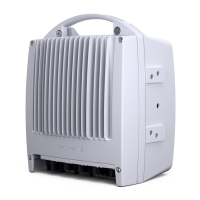MINI-LINKEandEMicro
6.1.5 Loop Tests
There are two different ways to use loops:
• Fault tracing by checking alarm signal status.
• Installation test (applicable for MINI-LINK E ) by connecting a t est signal
either to the SM U input test port (when used) or the MMU input test port
and then loop it back to the corresponding output test port for analysis (with
for example a BER-meter).
An Alarm Indication Signal (AIS) is generated at the traffic output when a loop
is set.
6.1.5.1 Loops for MINI-LINK E
Near-end Loops
Near-end looping tests are used to find out if any of the units in the near-end
ter minal is faulty (the SMU, MMU or RAU).
The following near-end loop tests are available (the numbers in brackets after
each l oop refer to Figure 68 on page 103):
SMU Tx Loop (N1)
In the SMU the traffic signal to be transmitted is,
immediately at the input, looped back to the output
(on the receiving side).
MMU Tx Loop (N2)
The traffic signal to be transmitted is looped back
at the input of the MMU.
MMU IF Loop (N3)
In the MMU the traffic signal to be transmitted is
after being modulated mixed with the frequency of
a local oscillator and looped back for demodulation
(on the receiving side).
RF Loop (N4)
(1)
In the RAU a fraction of the RF signal transmitted
is shifted in frequency and looped back to the
receiving side.
(1)
Not available for RAU1 26-E and RAU1 38-E
For further information, see section Block Diagrams over Loops on Page 104
and block diagrams of the RAUs in Section 3.3.1 on page 26, Section 3.4.1 on
page 31 and Section 3.5.1 on page 36.
102
AE/LZT 110 2012 R8C 2002-03-04

